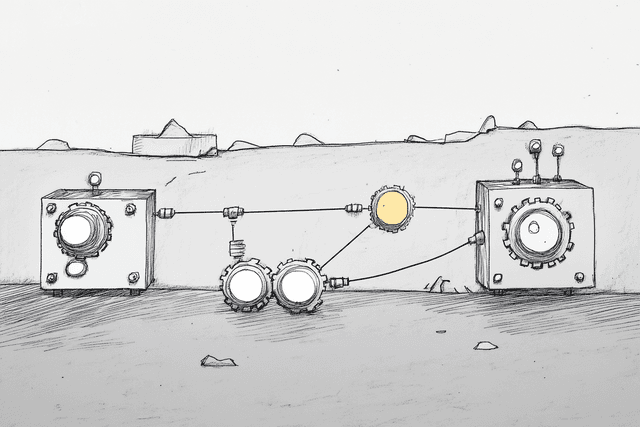DevOps is a set of practices that combines software development and IT operations. It aims to shorten the development lifecycle while delivering features, fixes, and updates frequently and reliably. Organizations implement DevOps to automate workflows, improve collaboration, and deploy code more efficiently. The DevOps market is projected to grow from $13.16 billion in 2024 to $81.14 billion by 2033 at a 19.95% compound annual growth rate.
DevOps tools help teams manage each phase of the software delivery process. This includes writing code, testing, deploying, monitoring, and maintaining systems. The right tools reduce manual work, improve consistency, and support team collaboration.
In this article, we'll explore 10 essential DevOps tools that modern software development teams use to streamline their workflows and improve productivity.
What Are DevOps Tools?
DevOps tools are software applications that automate or simplify tasks in the software development lifecycle. They help teams build, test, deploy, and monitor applications more efficiently. These tools enable developers and operations teams to work together more effectively by providing shared platforms and standardized processes.
DevOps tools address specific challenges in the development process:
Version control: Managing code changes from multiple developers
Continuous integration: Automatically building and testing code changes
Deployment automation: Consistently releasing software to different environments
Infrastructure management: Setting up and maintaining servers and services
Monitoring: Tracking application performance and identifying issues
Different tools specialize in different parts of the DevOps lifecycle. Some handle a single function, while others provide integrated platforms that cover multiple areas.
Version Control Systems
Version control systems track changes to source code over time. They allow multiple developers to work on the same codebase without conflicts and provide a history of all changes.
Git is the most widely used version control system today. It works by creating a local copy of the repository on each developer's machine. This approach allows developers to work offline and commit changes locally before sharing them.
Version control systems help teams collaborate by providing a structured way to propose, review, and merge code changes. They maintain a complete history of the codebase, making it possible to revert to previous versions if needed. Additionally, natural language processing (NLP) is automating 35% of routine operational tasks in DevOps, while AI-powered test generation covers 78% of edge cases in continuous testing pipelines.
GitHub: Offers features like pull requests, actions for CI/CD, and project boards
GitLab: Provides an integrated DevOps platform with built-in CI/CD pipelines
Bitbucket: Integrates well with other Atlassian products like Jira
Continuous Integration (CI) automatically builds and tests code changes when they're committed to the repository. Continuous Delivery (CD) extends this process by automatically deploying code to testing or production environments. For example, Amazon achieved deployment frequencies of every 11.7 seconds through microservices and automated pipelines, while Etsy increased deployment rates from twice weekly to over 50 daily releases.
Continuous Integration and Delivery Tools
Continuous Integration (CI) automatically builds and tests code changes when they're committed to the repository. Continuous Delivery (CD) extends this process by automatically deploying code to testing or production environments.
CI/CD tools run automated tests to verify that new code works correctly and doesn't break existing functionality. If tests pass, the code can be automatically deployed, reducing the time between writing code and making it available to users.
Popular CI/CD tools include:
Jenkins: An open-source automation server with hundreds of plugins
CircleCI: A cloud-based CI/CD service that runs builds in containers
GitHub Actions: Integrated CI/CD capabilities within GitHub repositories
GitLab CI/CD: Built-in pipelines that integrate with GitLab repositories
For example, a web development team might set up a CI/CD pipeline that automatically:1. Runs unit tests when code is pushed2. Builds the application if tests pass3. Deploys to a staging environment for manual testing4. Deploys to production after approval
Trunk offers CI/CD integration that helps teams identify and fix flaky tests—tests that sometimes pass and sometimes fail without code changes. This reduces build failures and improves developer productivity.
Configuration Management Tools
Configuration management tools help maintain consistent system configurations across different environments. They automate the process of setting up servers, installing software, and configuring services.
These tools use a declarative approach, where you define the desired state of your systems rather than writing step-by-step instructions. The tool then ensures that all systems match this definition.
Common configuration management tools include:
Ansible: Uses simple YAML files and doesn't require agents on managed servers
Puppet: Uses a declarative language to define system configurations
Chef: Uses Ruby-based recipes to describe system configurations
Configuration management tools help prevent the "it works on my machine" problem by ensuring that development, testing, and production environments are configured identically. They also make it easier to scale systems by automating the setup process.
Containerization and Orchestration
Containers package applications and their dependencies into a single unit that can run consistently across different environments. This solves the problem of applications working differently in development versus production.
Docker is the most popular containerization tool. It creates lightweight, portable containers that include everything needed to run an application. Docker containers start quickly and use resources efficiently.
When running many containers, orchestration tools help manage deployment, scaling, and networking. Kubernetes is the leading container orchestration platform. It automates:
Deploying containers across multiple servers
Scaling applications up or down based on demand
Managing network connections between containers
Monitoring container health and restarting failed containers
For example, a microservices application might use Docker to package each service as a container and Kubernetes to manage how these containers run together. If one service experiences higher demand, Kubernetes can automatically create more instances of that container.
Infrastructure as Code Tools
Infrastructure as Code (IaC) tools allow teams to define infrastructure using code instead of manual processes. This makes infrastructure provisioning repeatable, version-controlled, and less prone to human error.
With IaC, you describe servers, networks, and other resources in configuration files. These files can be stored in version control, reviewed like application code, and used to create or update infrastructure automatically.
Popular IaC tools include:
Terraform: Works with multiple cloud providers using a declarative configuration language
AWS CloudFormation: Creates and manages AWS resources using JSON or YAML templates
Pulumi: Uses general-purpose programming languages like Python or TypeScript
IaC makes it easier to maintain consistent environments and recover from failures. If a server fails, you can use the same code to create a replacement quickly. It also supports the practice of treating infrastructure as disposable—creating and destroying resources as needed.
Monitoring and Observability Tools
Monitoring tools collect data about application performance and system health. They help teams identify issues before they affect users and understand how systems behave in production.
Modern monitoring goes beyond basic metrics like CPU and memory usage. It includes:
Metrics: Numerical data about system performance
Logs: Detailed records of events and errors
Traces: Information about request flows through distributed systems
Popular monitoring tools include:
Prometheus: Collects and stores time-series metrics
Grafana: Creates dashboards to visualize monitoring data
ELK Stack (Elasticsearch, Logstash, Kibana): Collects, processes, and visualizes log data
Datadog: Provides unified monitoring across infrastructure, applications, and logs
These tools help teams respond quickly to incidents and make data-driven decisions about system improvements. For example, monitoring might reveal that a database query is running slowly during peak hours, allowing the team to optimize it before users notice performance issues.
Artifact Management Tools
Artifact management tools store and manage the files produced during the build process. These artifacts include compiled code, container images, libraries, and documentation.
Using a dedicated artifact repository provides several benefits:
Version control: Track different versions of artifacts
Access control: Limit who can publish or download artifacts
Dependency management: Manage libraries used by applications
Common artifact management tools include:
JFrog Artifactory: Supports multiple artifact types and integrates with CI/CD pipelines
Nexus Repository: Manages components, build artifacts, and release candidates
Docker Hub: Stores and distributes Docker container images
Artifact management is essential for maintaining a reliable software supply chain. It ensures that teams use consistent, approved versions of dependencies and that deployment processes have access to the correct artifacts.
Security and Compliance Tools
DevSecOps tools integrate security into the development process rather than treating it as a separate phase. They help identify and fix security issues early, when they're easier and less expensive to address.
These tools scan code, dependencies, and infrastructure for vulnerabilities and compliance issues. They can be integrated into CI/CD pipelines to provide automated security checks.
Key security tools include:
SonarQube: Analyzes code quality and security issues
OWASP Dependency-Check: Identifies known vulnerabilities in dependencies
HashiCorp Vault: Manages secrets like API keys and passwords
Snyk: Finds and fixes vulnerabilities in open-source dependencies
For example, a security scan might detect that an application uses a library with a known vulnerability. The team can then update to a patched version before deploying to production, preventing a potential security breach.
Trunk integrates with many security scanning tools, running them automatically during development to catch issues early. This helps teams maintain secure coding practices without slowing down their workflow.
Collaboration and Communication Tools
DevOps is as much about culture and communication as it is about technology. Collaboration tools help bridge the gap between development and operations teams by providing shared workspaces and communication channels.
These tools facilitate:
Knowledge sharing: Documenting processes and decisions
Incident response: Coordinating during outages or issues
Cross-team collaboration: Breaking down silos between teams
Popular collaboration tools in DevOps include:
Slack: Real-time messaging and integration with DevOps tools
Jira: Issue tracking and project management
Confluence: Documentation and knowledge sharing
PagerDuty: Incident management and on-call scheduling
Effective collaboration tools integrate with the rest of the DevOps toolchain. For example, a code change might trigger a notification in Slack, or a monitoring alert might automatically create a Jira ticket.
Standardized DevOps Toolchains
A standardized DevOps toolchain combines multiple tools into a cohesive workflow. Rather than using disconnected tools, teams create integrated pipelines where each step feeds into the next.
Benefits of a standardized toolchain include:
Consistency: All teams follow similar processes
Efficiency: Automation reduces manual handoffs
Visibility: Everyone can see the status of code from development to production
Creating a standardized toolchain involves:
Selecting tools that work well together
Configuring integrations between tools
Defining standard workflows and processes
Training teams on the toolchain
Trunk provides a standardized toolchain that integrates code quality tools, testing frameworks, and CI/CD systems. This helps teams maintain consistent practices across projects without manually configuring each tool.
Choosing the Right DevOps Tools
Selecting the right DevOps tools depends on your team's specific needs and constraints. Consider these factors:
Team size and structure: Larger teams may need more robust tools with advanced access controls
Technical stack: Choose tools that support your programming languages and frameworks
Existing tools: Look for new tools that integrate with what you already use
Budget: Balance open-source options with commercial tools that offer support
Learning curve: Consider how quickly your team can adopt new tools
Start with the most critical areas for improvement. If deployment is a bottleneck, focus on CI/CD tools first. If environment inconsistency causes problems, prioritize containerization or configuration management.
Remember that tools alone don't create a DevOps culture. They support the practices and principles that enable teams to deliver software more effectively.






